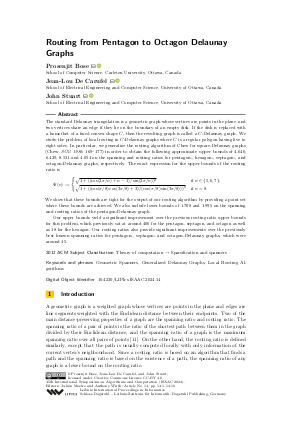Routing from Pentagon to Octagon Delaunay Graphs
Authors
Prosenjit Bose  ,
Jean-Lou De Carufel
,
Jean-Lou De Carufel  ,
John Stuart
,
John Stuart 
-
Part of:
Volume:
35th International Symposium on Algorithms and Computation (ISAAC 2024)
Part of: Series: Leibniz International Proceedings in Informatics (LIPIcs)
Part of: Conference: International Symposium on Algorithms and Computation (ISAAC) - License:
 Creative Commons Attribution 4.0 International license
Creative Commons Attribution 4.0 International license
- Publication Date: 2024-12-04
File

PDF
LIPIcs.ISAAC.2024.14.pdf
- Filesize: 1.34 MB
- 16 pages
Document Identifiers
Subject Classification
ACM Subject Classification
- Theory of computation → Sparsification and spanners
Keywords
- Geometric Spanners
- Generalized Delaunay Graphs
- Local Routing Algorithms
Metrics
- Access Statistics
-
Total Accesses (updated on a weekly basis)
0PDF Downloads0Metadata Views
Abstract
The standard Delaunay triangulation is a geometric graph whose vertices are points in the plane, and two vertices share an edge if they lie on the boundary of an empty disk. If the disk is replaced with a homothet of a fixed convex shape C, then the resulting graph is called a C-Delaunay graph. We study the problem of local routing in C-Delaunay graphs where C is a regular polygon having five to eight sides. In particular, we generalize the routing algorithm of Chew for square-Delaunay graphs (Chew. SCG 1986, 169-177) in order to obtain the following approximate upper bounds of 4.640, 6.429, 8.531 and 4.054 on the spanning and routing ratios for pentagon-, hexagon-, septagon-, and octagon-Delaunay graphs, respectively. The exact expression for the upper bounds of the routing ratio is Ψ(n):= √{1+((cos(2π/n)+n-1)/sin(2π/n))^2} (if n ∈ {5,6,7}), √{1+((cos(π/8)cos(3π/8)+3)/(cos(π/8)sin(3π/8)))^2} (if n = 8).
We show that these bounds are tight for the output of our routing algorithm by providing a point set where these bounds are achieved. We also include lower bounds of 1.708 and 1.995 on the spanning and routing ratios of the pentagon-Delaunay graph.
Our upper bounds yield a significant improvement over the previous routing ratio upper bounds for this problem, which previously sat at around 400 for the pentagon, septagon, and octagon as well as 18 for the hexagon. Our routing ratios also provide significant improvements over the previously best known spanning ratios for pentagon-, septagon- and octagon-Delaunay graphs, which were around 45.
Cite As Get BibTex
Prosenjit Bose, Jean-Lou De Carufel, and John Stuart. Routing from Pentagon to Octagon Delaunay Graphs. In 35th International Symposium on Algorithms and Computation (ISAAC 2024). Leibniz International Proceedings in Informatics (LIPIcs), Volume 322, pp. 14:1-14:16, Schloss Dagstuhl – Leibniz-Zentrum für Informatik (2024)
https://doi.org/10.4230/LIPIcs.ISAAC.2024.14
BibTex
@InProceedings{bose_et_al:LIPIcs.ISAAC.2024.14,
author = {Bose, Prosenjit and De Carufel, Jean-Lou and Stuart, John},
title = {{Routing from Pentagon to Octagon Delaunay Graphs}},
booktitle = {35th International Symposium on Algorithms and Computation (ISAAC 2024)},
pages = {14:1--14:16},
series = {Leibniz International Proceedings in Informatics (LIPIcs)},
ISBN = {978-3-95977-354-6},
ISSN = {1868-8969},
year = {2024},
volume = {322},
editor = {Mestre, Juli\'{a}n and Wirth, Anthony},
publisher = {Schloss Dagstuhl -- Leibniz-Zentrum f{\"u}r Informatik},
address = {Dagstuhl, Germany},
URL = {https://drops.dagstuhl.de/entities/document/10.4230/LIPIcs.ISAAC.2024.14},
URN = {urn:nbn:de:0030-drops-221411},
doi = {10.4230/LIPIcs.ISAAC.2024.14},
annote = {Keywords: Geometric Spanners, Generalized Delaunay Graphs, Local Routing Algorithms}
}
Author Details
- School of Electrical Engineering and Computer Science, University of Ottawa, Canada
References
- Nicolas Bonichon, Prosenjit Bose, Jean-Lou De Carufel, Vincent Despré, Darryl Hill, and Michiel Smid. Improved routing on the Delaunay triangulation. Discret. Comput. Geom., 70(3):495-549, 2023. URL: https://doi.org/10.1007/s00454-023-00499-9.
- Nicolas Bonichon, Prosenjit Bose, Jean-Lou De Carufel, Ljubomir Perkovic, and André van Renssen. Upper and lower bounds for online routing on Delaunay triangulations. Discret. Comput. Geom., 58(2):482-504, 2017. URL: https://doi.org/10.1007/s00454-016-9842-y.
- Nicolas Bonichon, Cyril Gavoille, Nicolas Hanusse, and Ljubomir Perkovic. Tight stretch factors for L_1- and L_∞-Delaunay triangulations. Comput. Geom., 48(3):237-250, 2015. URL: https://doi.org/10.1016/j.comgeo.2014.10.005.
- Prosenjit Bose, Paz Carmi, Sébastien Collette, and Michiel H. M. Smid. On the stretch factor of convex Delaunay graphs. J. Comput. Geom., 1(1):41-56, 2010. URL: https://doi.org/10.20382/jocg.v1i1a4.
- Prosenjit Bose, Jean-Lou De Carufel, Stephane Durocher, and Perouz Taslakian. Competitive online routing on Delaunay triangulations. Int. J. Comput. Geom. Appl., 27(4):241-254, 2017. URL: https://doi.org/10.1142/S0218195917500066.
- Prosenjit Bose, Rolf Fagerberg, André van Renssen, and Sander Verdonschot. Optimal local routing on Delaunay triangulations defined by empty equilateral triangles. SIAM J. Comput., 44(6):1626-1649, 2015. URL: https://doi.org/10.1137/140988103.
- Prosenjit Bose and Pat Morin. Competitive online routing in geometric graphs. Theor. Comput. Sci., 324(2-3):273-288, 2004. URL: https://doi.org/10.1016/j.tcs.2004.05.019.
- Paul Chew. There is a planar graph almost as good as the complete graph. In SCG, pages 169-177. ACM, 1986. URL: https://doi.org/10.1145/10515.10534.
- Paul Chew. There are planar graphs almost as good as the complete graph. J. Comput. Syst. Sci., 39(2):205-219, 1989. URL: https://doi.org/10.1016/0022-0000(89)90044-5.
- Lihong Ma. Bisectors and Voronoi Diagrams for Convex Distance Functions, volume 267 of Informatik-Berichte. FernUniversität in Hagen, Hagen, 2000. Zugl.: Dissertation, FernUniversität in Hagen, 2000. URL: https://ub-deposit.fernuni-hagen.de/receive/mir_mods_00000857.
- Giri Narasimhan and Michiel Smid. Geometric Spanner Networks. Cambridge University Press, 2007. URL: https://doi.org/10.1017/CBO9780511546884.
- Ljubomir Perkovic, Michael Dennis, and Duru Türkoglu. The stretch factor of hexagon-Delaunay triangulations. J. Comput. Geom., 12(2):86-125, 2021. URL: https://doi.org/10.20382/jocg.v12i2a5.
- Ge Xia. The stretch factor of the Delaunay triangulation is less than 1.998. SIAM J. Comput., 42(4):1620-1659, 2013. URL: https://doi.org/10.1137/110832458.
- Ge Xia and Liang Zhang. Toward the tight bound of the stretch factor of Delaunay triangulations. In CCCG, 2011. URL: http://www.cccg.ca/proceedings/2011/papers/paper57.pdf.
